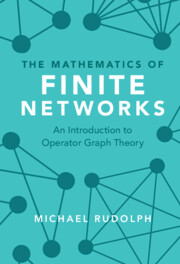Book contents
- Frontmatter
- Dedication
- Contents
- Preface
- 1 Introduction
- Part I Operator Graph Theory
- 2 Classical Graph Theory: The Mathematical Description of Networks
- 3 Operator Calculus: The Mapping between Vector Spaces
- 4 Operator Graph Theory: The Mathematics of Finite Networks
- Part II Applications
- Afterthought
- Bibliography
- Index of Notations
- Subject Index
3 - Operator Calculus: The Mapping between Vector Spaces
from Part I - Operator Graph Theory
Published online by Cambridge University Press: 30 April 2022
- Frontmatter
- Dedication
- Contents
- Preface
- 1 Introduction
- Part I Operator Graph Theory
- 2 Classical Graph Theory: The Mathematical Description of Networks
- 3 Operator Calculus: The Mapping between Vector Spaces
- 4 Operator Graph Theory: The Mathematics of Finite Networks
- Part II Applications
- Afterthought
- Bibliography
- Index of Notations
- Subject Index
Summary
Leonard Euler’s ingenious approach to the conundrum which surrounded the seven bridges of Königsberg provided us not only with the definite solution to this intriguing problem, but also planted the seed from which the mathematical field of graph theory germinated. Although Euler’s now-historic negative resolution ended the tedious explorative search for a viable path through the city by inspired inhabitants and visitors of this Prussian town, this brute-force approach certainly merits further investigation in light of many modern-day problems which rely on such an approach due to the lack of better options. Is it possible to formulate this active exploration of the network of Königsberg’s bridges in mathematical terms? The affirmative answer to this question leads us to another field of mathematics, operator theory. This chapter will provide a coarse introduction into the very basics of operator calculus, the algebraic tool utilised to describe operations on and mappings between finite vector spaces. The application of this formalism to graph-theoretical objects will then establish the conceptual framework for Operator Graph Theory, the central objective of this book.
- Type
- Chapter
- Information
- The Mathematics of Finite NetworksAn Introduction to Operator Graph Theory, pp. 88 - 116Publisher: Cambridge University PressPrint publication year: 2022



